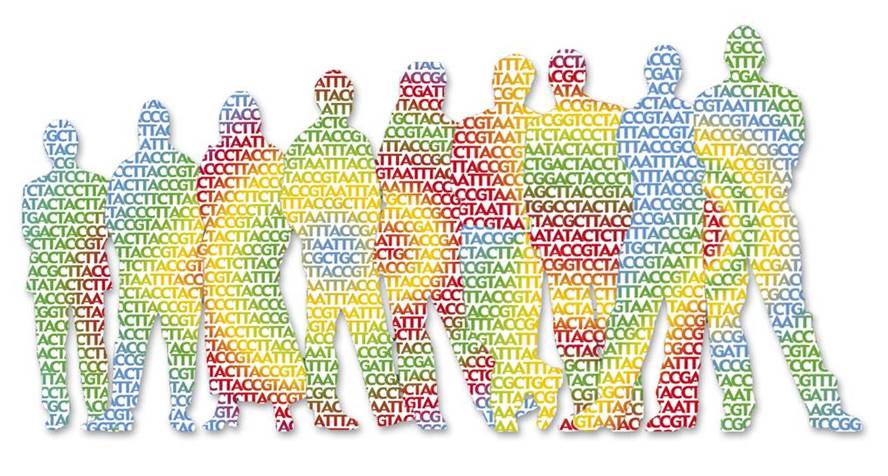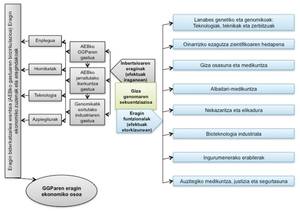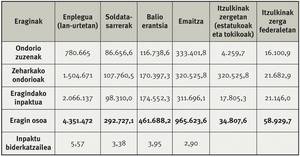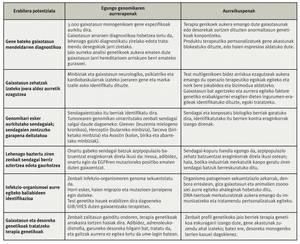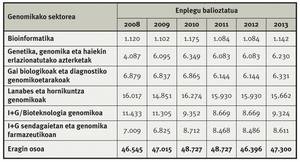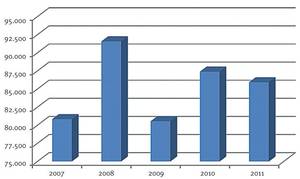Returns of the human genome project
The crisis has brought with it cuts in all areas of society, and we see constantly in the media that the main pillars of the “welfare state” (health, education, working conditions...) are lost every Friday, when the Council of Ministers publishes the decrees of the week. The staff of public institutions are in a situation of anguish and anguish to maintain proper services, and their complaints and protests by users cover the streets daily.
But there is another social pillar that is suffering the seriousness of this situation, but that does not appear so much in the media: science, or rather, research. Especially at the state level, funding cuts in major research institutions have put their sustainability into question. The best known example is probably the CSIC: It has had to deal with a reduction of 500 million euros since 2010, and at this time it is not clear how it will arrive at the end of this year. Globally, and with data from April this year, investment in scientific research in Spain has decreased by 39% since 2009.
According to the scientists, these cuts jeopardize the future of science in Spain, since the investigations can not be interrupted now and after a few years continue with them, from the point that was left; in most cases it is necessary to start from zero to return to the levels reached in the last decades. And scientists believe that without science there is no future; without it, to achieve innovation and the development of other areas of society, we have to buy knowledge and technology from the outside.
To see the truth about the relationship between investment in science and the achievement of economic benefits, I will take an example that has become a milestone in recent years, on the one hand, in a spectacular advance in the world of science and, on the other, because it is already giving great returns in the economy, even though the most important benefits will come in the coming years.
Human Genome Project (GGP)
The Human Genome Project was a 13-year work that began in 1990 and officially ended in 2003 with the detection and publication of between 20,000 and 25,000 genes. Among its objectives were to find a complete sequence of 3.000 million subunits or bases and to analyze the legal and ethical problems raised.
The project was coordinated by the United States Department of Energy (DOE) and the Institutes of Health (NIH), and later the British Wellcome Trust met, to which several nations joined: Japan, France, Germany, China, etc.
The sequencing of the human genome is the greatest work done in the history of biological science and has been a milestone among scientific achievements. To understand why, let's give some data: It was an international project led by the United States, with a private complementary program, which was developed in a short term of 13 years, for which it was necessary to develop advanced technology and form a multidisciplinary team: biologists, chemists, physicists, computer scientists, mathematicians and engineers.
Currently, scientists use the genome as a sequenced reference, its structure and other data extracted from GGP are the basis for achieving essential advances in medicine and science, with the aim of preventing, diagnosing and treating human diseases.
This knowledge, centred on human models and organisms, goes beyond biomedicine, is a "genomic revolution" and its effects are going to be multiple: renewable energies, industrial biotechnology, veterinary science, environmental science, forensic medicine and public safety, and between disciplines, zoology, ecology, anthropology...
General Conclusions General Conclusions
1. The economic and functional effects of the sequencing of the human genome are enormous and widespread. The sequencing projects of the human genome between 1988 and 2012, and the impacts generated by direct and indirect industrial research and activities related to it, were as follows: 965 billion dollars of economic impact, 293 thousand salary income and 4.3 million years of work.
2. The federal government directly invested GGP 3.8 billion dollars until its completion in 2003, and later 9.1 billion until 2012. This investment generated an economic result of 796 billion dollars until 2010, with a return of the relationship 178/1, that is, every dollar of the investment has generated in the economy 178.
3. In annual terms, the genomic industry generated in 2010 an economic income of 3.7 billion euros and 3.9 billion dollars in 2012; and from the tax point of view - federal and local - 2.3 billion were collected in 2010 and 2.1 billion in 2012. Taking these figures, it is observed that the returns of one year are equivalent to the total investment of the GNP of 13 years, while analyzing the period 1988-2012, with an annual investment of 2 dollars per inhabitant in the US, one billion dollars is obtained.
4º But it has only begun. The best large-scale benefits in human medicine, agriculture, energy and the environment are to come.
5. We could say that PDR is the biggest impact investment in current science and the basis for the progress of biological sciences.
Functional effects of PDR
But despite the enormous economic effects of GGP, it is not the most important thing, since the main objective was to improve the knowledge of our biology, health and well-being. The project was organized with the aim of clarifying the basic molecular processes that govern life, as well as the advancement of genomic knowledge and technology in other areas.
The diffusion of basic biological knowledge that has generated the use of these tools, technologies and techniques has been enormous and has provoked a change of scientific paradigm, that is, the GGP has changed the way scientists understand biology.
There is another feature to highlight. As I was clarifying the sequence of DNA, it was published daily through the Internet to be able to use the data immediately. Due to the usefulness of this genomic information, the identification of the mechanisms of diseases, the diagnoses of diseases and genetic imbalances, the clarification of the metabolic routes and the biological elements that intervene in complex diseases, as well as the detection of target specific for drugs, have suffered a radical transformation. Likewise, the clarification of the entire sequence of human DNA has led to improvements in biomedicine, such as genetic therapy, the development of vaccines, regenerative medicine, stem cell therapies, and the compatibility of organs and tissues between donors and receptors.
However, in addition to expanding the usual medical aspects, the sequencing of DNA has generated new fields, such as pharmacogenomics and personalized diagnostics, with the aim of locating drugs and adjusting the therapeutic doses corresponding to the patient's genetic profile, increasing efficiency and reducing adverse side effects. It has already been used in the treatment of some types of cancer and we will see pharmacogenomics XXI. The revolution of the twentieth century in medical practice.
Biotechnology in the Basque Country
Ten years after the publication of the Biobask Plan 2010, the biotechnology sector has grown and consolidated among the Basque economic sectors. This plan also emphasizes that the uses derived from genomics will have enormous economic and social consequences. In 2003, the Autonomous Community of the Basque Country had 24 companies employing biotechnological processes, with the aim of creating 40 new companies with an average staff of 100 workers. According to EUSTAT data, in 2011 there were 63 biocompanies with an average staff of 41 workers. Expenditure on R&D in this sector has varied year after year to 86 million euros in 2011.
As for the public sector, seeing that in this century the convergence of the different sciences was going to take place, in 2002 the Basque Government opened the Cooperative Research Centers (CIC), where the public and private entities dedicated to research, both Basque and foreign, meet. Currently there are two centers that work biotechnology: CIC Biogune, of biosciences, and CIC Biomagune, of biomaterials, with about 250 researchers from 17 different countries, who in the period 2002-2011 managed an operating income of 160 million euros.
The Basque biotechnology sector is young and still small compared to other sectors. For example, the information and communication technology sector, that is, the ICT sector, has 2,055 companies and 22,000 workers, which represents 3.2% of the CAPV's GDP. We will have to see how the crisis blow affects the sector. On the one hand, it will be necessary to see if the public financing will be reduced, which will be possible to maintain the level of the CIC centers and, on the other, in the case of companies, those that do not have their own structure sufficiently solid and that require public subsidies or external financing.
Until recently, long periods were needed to detect returns of science, since the year or decade a new concept emerged until its practical uses were available. As the deadlines are shortened, it is increasingly evident that science and research are basic tools for building the future of a people.
The Intrinsic Importance of Science
However, the main social returns of research are not those that generate short-term or long-term economic benefits. Many times it is impossible to know in advance what problems science will solve. For example, when in 1928 the physicist Paul Dirac proposed the existence of the positron, no one thought that today it would be possible, thanks to the tomography of positron emission, to take three-dimensional images of some processes that take place in the body. Pedro Miguel Etxenike affirmed that "a society well formed in science is freer to make decisions; in addition, to obtain economic benefits it is necessary a harmonious and sustainable development of the basic and the applied".



